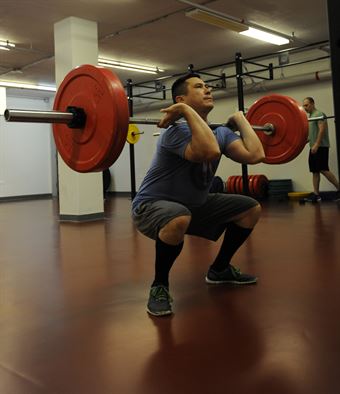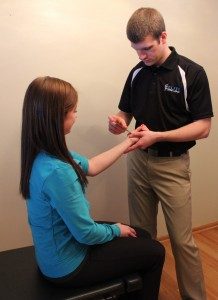CrossFit Injuries: Elbow Pain

Elbow Pain (Tendonitis)
Many people don’t typically think of elbow pain or elbow tendonitis as a common CrossFit injury. However, CrossFitters frequently suffer from nagging elbow pain. Repeated overuse of the forearm muscles causes elbow tendonitis, more commonly known as lateral epicondylitis or medial epicondylitis.
Symptoms of Elbow Tendonitis
Sharp pain at the outside or inside of the elbow over the bone classically represents this condition. Tendons are the elastic structures that connect muscles to bone. The term tendonitis refers to an inflammation of the tendon as it attaches to the bone.
Healing in our bodies creates inflammation as a normal process. We all experience the pain, swelling, redness and warmth that comes with inflammation after an injury. The inflammation response is supposed to be temporary, not chronic or prolonged. However compared to the muscle belly, the tendon heals very slowly due to limited blood supply. This can result in failed healing and an inflammation response that becomes chronic or even systemic. Which can make it incredibly difficult to manage and annoyingly painful.
You may also commonly experience pain down your forearm towards the wrist. Lifting or bending the arm throughout the day often elicit painful symptoms as well. Performing basic actions such as writing, using a computer mouse, or gripping small objects like a pen can also recreate symptoms. Other common movements become painful like twisting your forearm when turning a door handle or attempting to fully extend your forearm. Without treatment symptoms can frequently last two to three months.
 What causes elbow tendonitis?
What causes elbow tendonitis?
Elbow tendonitis is classified as a repetitive strain injury. This means overuse of the forearm muscles causes the pain being felt in the elbow. The muscles that control wrist extension and flexion run along the forearm and connect around the elbow joint. Repeated strain on the wrist can lead to elbow tendonitis, such as activities performed by professional tennis players or golfers. It’s also common among people who are new to certain sports, like CrossFit, and are not used to the demands of the WOD. Our bodies need time to become conditioned to new movements, especially repetitive movements. Highly repetitive movements before the body has adapted, such as high volume pull-ups, cleans, WODs involving a front rack position, and even computer typing for most of the day, can lead to tendonitis.
Self Treatment
Generally speaking, if symptoms persist for longer than two or three weeks, a visit to your sports chiropractor may be in order. However, we will give you several ways you can prevent and treat tennis elbow before it becomes a more troubling issue.
Check your technique. If the pain presents as sport or activity-specific, you must improve your technique or ergonomic setup. Consult your coach to ensure that you are performing each movement at the box in the right way. Kinesio-taping can assist with technique feedback as well, here are RockTape applications for the wrist and forearm.
Stretch. Perform wrist flexor and extensor muscle stretches so that you feel a stretch or pull along the muscles but no elbow pain. You can also find most of our wrist stretches, exercises, and mobilizations on our YouTube channel, with new content being added all the time.
Don’t play through the pain. You know when something does not feel quite right. Muscles and joints get sore often, but should feel better as you warm up and move into your workout. If your soreness lingers or increases to pain as you continue through the workout, that signifies a strong indication of something potentially more serious. In that situation cut the workout short, address the issue, and don’t let it turn into a long-term, nagging injury.
Prevention
Get soft tissue or myofascial release work done. Doing so will help break up scar tissue to facilitate healing when the issue is new within the first few weeks. At this point, visit a sports chiropractor, physical therapist, or a sports massage therapist. Lacrosse ball massage can help prevent sore wrist and forearm muscles from becoming continuously over-stressed in repetitive CrossFit WODs, as well.
Maintenance work. Occasional maintenance visits to your sports chiropractor to make sure your wrist and elbow joints are moving well and forearm muscles are functioning properly are a great way to catch minor issues early and prevent potential injuries from occurring.
Sports Chiropractors & Elbow Pain
On your first visit to a sports chiropractor, we will fully assess your wrist and elbow movement and function. We will also perform several orthopedic tests to evaluate the need for any diagnostic imaging. Once we properly diagnose your injury, we will start a targeted sports chiropractic treatment plan. Our treatments methods include several soft tissue and joint mobilization techniques in addition to manipulation. Soft tissue treatments, such as Graston Technique or myofascial release, help reduce muscle tension and strain to improve range of motion and reduce pain. McKenzie Method is an advanced assessment, classification, treatment, and prevention protocol for musculoskeletal injuries.
We will also prescribe individual, specific corrective exercises for you to perform at home to speed your recovery. This WILL require homework from you! We encourage a team approach to treatment at Elite Sport & Spine. We are not here just to fix you, we want to educate you on why this injury occurred and give you the information you need to keep it from happening again!
This article is part of a series looking at common CrossFit and lifting injuries, how to prevent them, and how to treat them if they do occur. We cover the following injuries:
- Low Back Pain/Sciatica
- Knee Pain
- Shoulder Pain (Impingement)
- Neck Pain
- Elbow Pain (Tendinitis)
 262-373-9168
262-373-9168




